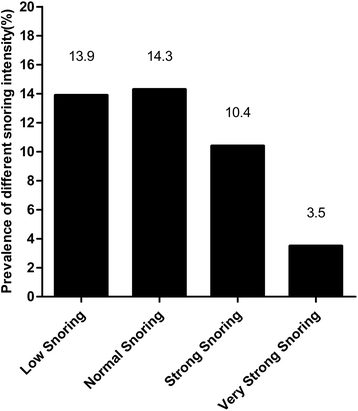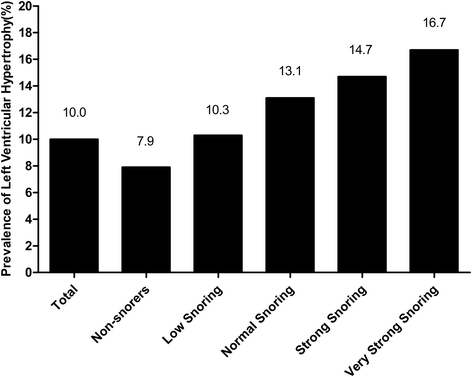The relationship between snoring and left ventricular hypertrophy of China: a cross-sectional study
- PMID: 26772538
- PMCID: PMC4714535
- DOI: 10.1186/s12872-016-0185-7
The relationship between snoring and left ventricular hypertrophy of China: a cross-sectional study
Abstract
Background: Population-based investigations studying the association between snoring and left ventricular hypertrophy (LVH) are lacking. Therefore, our study aims to investigate whether snoring is significantly associated with LVH, and to make clear the effect of varying degrees of snoring intensity on LVH.
Methods: A total of 10,139 participants were involved in this cross-sectional study. Snoring status and snoring intensity were evaluated by a structured questionnaire. LVH was defined as left ventricular mass index ≥ 51 g/m(2.7) for both men and women.
Results: The total prevalence of LVH was 10.0%. the prevalence increased significantly in snorers according to snoring intensity, including low (10.3%), normal (13.1%), strong (14.7%) and very strong (16.7%). After adjustment for age, race, gender, educational status, physical activity, annual income, current smoking status, current drinking status, sleep duration, hypertension, body mass index, waist circumference, low-density lipoprotein cholesterol, high-density lipoprotein cholesterol, triglyceride, total cholesterol and fasting plasma glucose, snoring (OR, 1.371; 95% CI, 1.147-1.637, P < 0.001) was significantly associated with LVH. In addition, among the four kinds of intensity of snoring, normal (OR, 1.436; 95% CI, 1.126-1.832, P = 0.004), strong (OR, 1.462; 95% CI, 1.124-1.902, P < 0.001) and very strong (OR, 1.813; 95% CI, 1.273-2.684, P < 0.001), rather than low (OR, 1.094; 95% CI, 0.834-1.434, P = 0.518) were significantly associated with LVH.
Conclusions: Snoring is independently associated with LVH. What's more, with the rise in snoring intensity, snoring will exert an increasing effect on LVH.
Figures


References
Publication types
MeSH terms
Substances
LinkOut - more resources
Full Text Sources
Other Literature Sources
Medical

